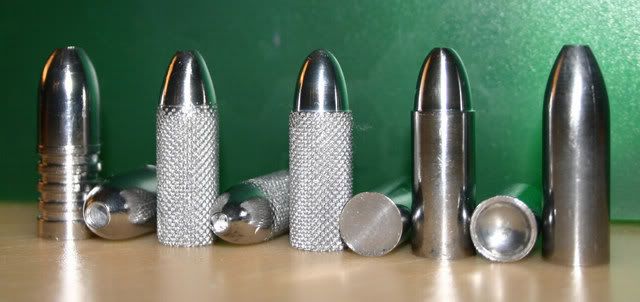Thank you for pointing out the .337, that is a pypo--it should be .437.
BJJ,
I get bored in the winter when the temp drops down too single digits and below and that is when I try to figure out what these bullets do other then hitting game or paper or how different alloys perform, and bullet diameters.
My passion is PP and I read from posts were people ask why do I get lead rings and paper rings or why this or why that.
Well I like to find the answers, so to get around the boredom when I can only shoot 8 or 10 rounds before I loose the feeling in my bare fingers so I do this.
The short case deal, I dont have a lead ring or paper ring problem shooting GG or swaged PP bullets. My cases are cut to .002 under chamber length with a fired case.
The reason is that I dont want a gap between the case mouth and the end of the chamber were the taper starts into the land, it's that gap that cuts the rings and also on the PP bullet cuts the patch when the bullet obtrudes, you can see that very clear on picture 7 & 8 that bright ring is the space between the case mouth and the end of the chamber, well that rind is the part of the side wall of the bullet that gets shaved off and makes the lead or paper ring, and cuts off the lower part of the patch and in turn leads the bore.
Maybe you can help me on this puzzle I found on this test.
Look at bullet 4 & 5 the picture below are the same two bullets. Never in my life have I recovered bullets were the bullet was stretched insted of getting compressed when it was fired, and in my life of shooting were I recovered most likely more then a 5 gallon bucket full of bullets shot into snow banks to recover the bullet mostly undamaged have I seen this.
Those two bullets I swaged down so I can wrap them with .003+ thick paper, I talk to some guys that use this thick paper and I was curious just what it did.
I dont use a patch that is thicker then the depth of the groove of the barrel, my feeling is that that bullet does not rotate as fast as it would with the thinner paper because it might strip.
but looking at #5 my thinking is with the short case and the thick paper when the bullet obtruded the paper was pushed in the void and held back the base for just a micro second and let the front portion pull before the paper cut and let the base follow.
Bullet #4 was wrapped the same but I think with the hollow point on that nose compressed that bullet on impact because that ring is almost closed.
Those bullets looked like the bullet on the right before they were fired.
I would like to have you guys input on this.
Kurt
